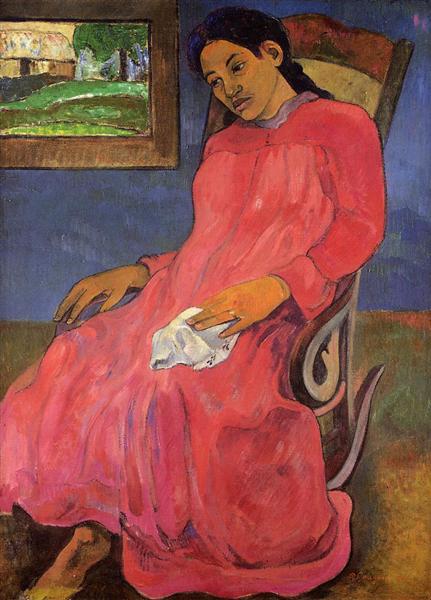Descrizione
Paul Gauguin's Melancholic, created in 1891, is an iconic piece that captures the essence of the emotional complexity and symbolism that characterizes much of his work. Set against a backdrop of personal and artistic searching, this painting becomes a mirror of the anguish and introspection that defines the human experience. The central figure, a pensive-looking young woman, appears to be in a state of deep contemplation, a clear reflection of the melancholy that gives the work its title. Her pale, serene face stands out against a background dominated by dark tones and deep blues, creating a strong contrast that intensifies the feeling of isolation.
Gauguin, known for his use of colour and exploration of symbolism, employs a palette that ranges from blue to emerald green and hints of red, creating an atmosphere that evokes both sadness and mystery. The arrangement of colours not only gives depth to the work, but also establishes a dialogue between the solitary figure and the surrounding space. This interaction is fundamental to understanding the emotional impact that the painting seeks to convey.
The background of the composition is equally significant. The organic and abstract forms surrounding the woman seem to allude to an inner world, where nature and the psyche are intertwined. This approach is characteristic of Gauguin's period in which he was moving away from realistic representation towards a more symbolic and expressive style, influenced by his experiences in Tahiti, although in this work the evocative palette manifests itself in other ways. Indeed, in many of his works, including "Melancholic", the internal experience of his characters is examined, making his compositions a visual exploration of the human condition.
Gauguin was drawn to themes of nostalgia and disenchantment, which is evident not only in this painting, but also in works such as The Spirit of the Earth and The Vision of the Sermon. In Melancholic, the feeling of loss and the longing for a deeper connection with the world hangs in the air, inviting the viewer to reflect on their own emotions. The woman, with her pensive countenance, could symbolize the internal struggle to find meaning in a reality that often feels unattainable or distant.
The choice of a female figure at the center of the painting is also significant. Often, women in Gauguin's art represent not only beauty but also a range of emotional states, from sadness to joy. In "Melancholic," her distant expression suggests a connection to the female experience of disillusionment and longing for transcendence, recurring themes in his work that weigh simplicity of form against the complexity of human experience.
In short, Melancholic stands out as a work rich in symbolism and emotion, where the solitary figure of the woman becomes a vehicle through which Gauguin explores melancholy and introspection. The combination of a carefully selected palette and a reality-defying composition invites the viewer to engage in a sort of internal dialogue, evoking feelings of nostalgia and contemplation. Thus, this painting stands out not only as an artistic representation of melancholy, but also as a profound reflection of the search for meaning and connection in a world that often feels bleak and isolating.
KUADROS ©, a famous painting on your wall.
Hand-made oil painting reproductions, with the quality of professional artists and the distinctive seal of KUADROS ©.
Painting reproduction service with satisfaction guarantee. If you are not completely satisfied with the replica of your painting, we will refund 100% of your money.

